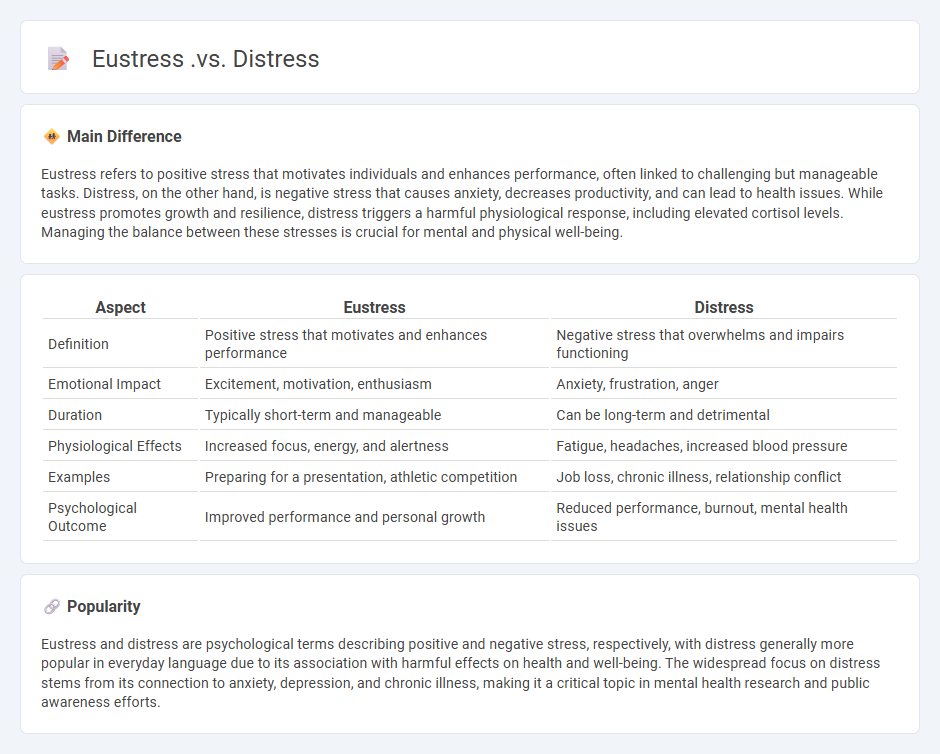
Eustress and distress are two distinct types of stress with contrasting effects on the body and mind. Eustress acts as a positive stimulus that enhances motivation, focus, and performance, while distress leads to negative outcomes such as anxiety, fatigue, and decreased productivity. Explore the differences between eustress and distress to better manage stress for improved well-being.
Main Difference
Eustress refers to positive stress that motivates individuals and enhances performance, often linked to challenging but manageable tasks. Distress, on the other hand, is negative stress that causes anxiety, decreases productivity, and can lead to health issues. While eustress promotes growth and resilience, distress triggers a harmful physiological response, including elevated cortisol levels. Managing the balance between these stresses is crucial for mental and physical well-being.
Connection
Eustress and distress are connected as two forms of stress that impact psychological and physiological health differently. Eustress stimulates motivation and enhances performance by promoting positive stress responses, while distress triggers negative outcomes such as anxiety, fatigue, and impaired cognitive function. Both types of stress activate the hypothalamic-pituitary-adrenal (HPA) axis but result in contrasting hormonal and emotional effects.
Comparison Table
| Aspect | Eustress | Distress |
|---|---|---|
| Definition | Positive stress that motivates and enhances performance | Negative stress that overwhelms and impairs functioning |
| Emotional Impact | Excitement, motivation, enthusiasm | Anxiety, frustration, anger |
| Duration | Typically short-term and manageable | Can be long-term and detrimental |
| Physiological Effects | Increased focus, energy, and alertness | Fatigue, headaches, increased blood pressure |
| Examples | Preparing for a presentation, athletic competition | Job loss, chronic illness, relationship conflict |
| Psychological Outcome | Improved performance and personal growth | Reduced performance, burnout, mental health issues |
Eustress
Eustress, a positive form of stress, enhances motivation and cognitive function by activating the body's adaptive responses to manageable challenges. It stimulates the release of hormones like adrenaline and cortisol at optimal levels, improving focus and energy without causing harm. Research in psychology links eustress to better performance, resilience, and overall mental well-being. Distinguishing eustress from distress is crucial for developing effective stress management strategies and promoting healthy psychological outcomes.
Distress
Distress in psychology refers to a negative psychological state resulting from exposure to stressors that overwhelm an individual's coping abilities. It is often characterized by symptoms such as anxiety, depression, irritability, and physical manifestations like increased heart rate or fatigue. Prolonged distress can impair cognitive function, disrupt daily activities, and contribute to the development of mental health disorders such as generalized anxiety disorder or major depressive disorder. Effective management strategies include cognitive-behavioral therapy, mindfulness techniques, and, in severe cases, pharmacological intervention.
Coping Mechanisms
Coping mechanisms are strategies used to manage stress, emotions, and difficult situations, crucial in psychological resilience. Common types include problem-focused coping, which addresses the source of stress, and emotion-focused coping, aimed at regulating emotional responses. Research indicates that adaptive coping strategies such as mindfulness and cognitive reappraisal improve mental health outcomes, while maladaptive methods like avoidance can exacerbate psychological distress. Understanding individual differences in coping styles helps tailor therapeutic interventions effectively.
Adaptive Stress
Adaptive stress refers to the type of stress response that enhances an individual's ability to cope with challenges and promotes resilience. This form of stress activates the hypothalamic-pituitary-adrenal (HPA) axis, leading to the release of cortisol, which mobilizes energy and sharpens cognitive function. Short-term adaptive stress improves learning, memory, and immune system function by preparing the body for efficient threat management. Chronic or excessive stress, however, can overwhelm these adaptive systems, impairing psychological and physiological health.
Maladaptive Stress
Maladaptive stress refers to the body's inability to effectively cope with prolonged or intense stressors, leading to negative psychological and physiological outcomes. Chronic exposure to maladaptive stress can increase the risk of mental health disorders such as anxiety, depression, and post-traumatic stress disorder (PTSD). It disrupts the hypothalamic-pituitary-adrenal (HPA) axis, causing hormonal imbalances like elevated cortisol levels, which impact brain function and immune response. Effective interventions include cognitive-behavioral therapy (CBT) and stress management techniques aimed at promoting adaptive coping mechanisms.
Source and External Links
Distress vs. Eustress: Types of Stress Explained - Talkspace - Distress is negative stress causing anxiety, tiredness, and poor physical/emotional states, while eustress is positive stress that energizes, builds confidence, and improves mental well-being.
Eustress Vs. Distress: Positive & Negative Types of Stress - Eustress provides productive energy, motivation, and improved performance, whereas distress causes restless energy, decreased focus, procrastination, and impairs performance.
Eustress vs. distress: Difference, examples, and effects - Eustress feels challenging but manageable, leading to growth and accomplishment, while distress is overwhelming, difficult, and negatively impacts health and performance.
FAQs
What is stress?
Stress is the body's physiological and psychological response to perceived challenges or threats, triggering the release of hormones like cortisol and adrenaline.
What is the difference between eustress and distress?
Eustress is positive stress that enhances motivation and performance, while distress is negative stress that causes anxiety and decreases functioning.
What are examples of eustress?
Examples of eustress include preparing for a job interview, competing in a sports event, starting a new hobby, taking on challenging projects at work, and public speaking engagements.
What are examples of distress?
Examples of distress include anxiety, depression, grief, financial strain, chronic illness, and workplace stress.
How does eustress affect the body and mind?
Eustress enhances the body by boosting immune function, increasing energy levels, and improving cardiovascular health while sharpening the mind by enhancing focus, motivation, and emotional resilience.
How does distress impact health?
Distress triggers chronic stress responses that impair immune function, elevate inflammation, increase cardiovascular risk, and contribute to mental health disorders such as anxiety and depression.
Can stress be both positive and negative?
Stress can be positive (eustress), enhancing motivation and performance, or negative (distress), causing anxiety and impaired function.
 calledges.com
calledges.com